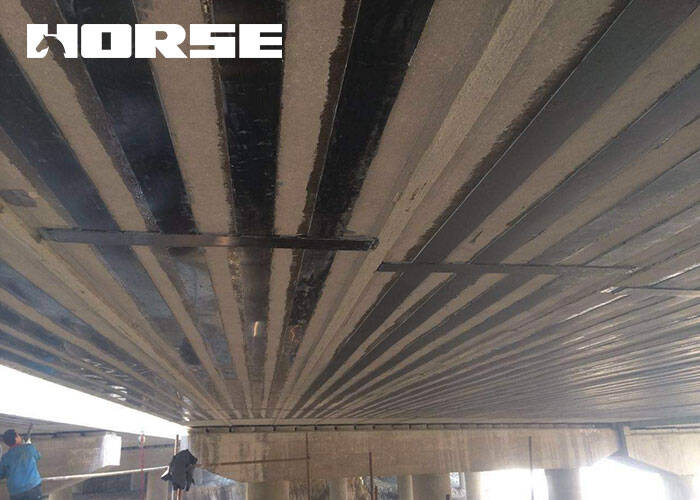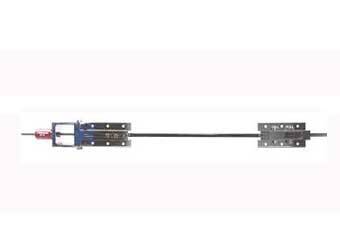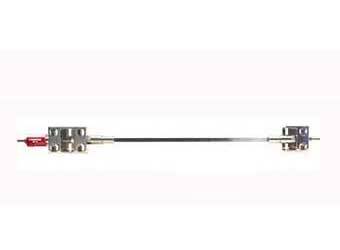Solutions
Horse Construction offers full range of structural strengthening materials with technical supports, documentation supports, products supports, project supports.
Reinforcement Of Transverse Cracks In Bridge Beams With Prestressed Carbon Fiber Plate

1. Construction preparation and measuring line
(1) According to the actual topography of the site, use scaffolding and suspension to build a facility engineering platform, calibrate the tension jack and the oil meter, and perform all related experiments on the carbon fiber plate.
(2) Loft the bottom plate of the beam according to the design drawings, and use the ink fountain to perform the line, and then use the steel bar locator to verify the position of the steel bar, fine-tune the line position, and determine the position of the carbon fiber plate and anchors at both ends.
2. Beam surface treatment
Polish the surface of the concrete base and ensure the surface flatness of the concrete base. If the flatness does not meet the requirements of <5mm/2m length, it is necessary to level the concrete base layer with epoxy repair glue.
Treat the surface of the concrete base layer with a vacuum cleaner or a blower to ensure that the sticking surface is flat and free of dust. In the grassroots treatment, it is strictly forbidden to cut grooves or cut holes on the structural concrete to ensure minimal damage to the structure.
3 drilling
The anchor bolts are implanted with percussion drills to drill holes on the concrete surface of the beam body according to the predetermined position of the design, chemical glues are installed, and high-strength stainless steel anchor bolts are planted. The use of ordinary carbon steel is strictly prohibited. The bore diameter of the anchor bolt shall not be greater than 22mm to ensure minimum damage to the beam structure.
4 Install the tension end and the fixed end support seat
After the implanted anchor bolt reaches the design strength, install the fixed section and the tension section support seat, apply special epoxy glue to the support seat clamp and the concrete surface, and tighten the bolt.
5 Carbon fiber plate is unloaded, cleaned and pasted on site
According to the design requirements and the length measured on site, the blanking length of the carbon fiber plate is determined according to this distance (the blanking length must consider the tensile length). Then cut the material on site, that is, cut off the carbon fiber plate on site, and scrub both ends of the carbon fiber plate with acetone. At the same time, the special fast bonding adhesive is prepared. And apply the prepared special quick-bonding glue to its end. Quickly close the upper and lower wave tooth plates of the wave anchor, and immediately tighten the wave anchor. Since the quick-bonding glue will solidify in about 1 to 5 minutes, the fastening of the wave anchor must be completed within this time.
6 Tensioning machine fixation and rapid pre-stress tensioning of carbon fiber plate
(1) Preliminarily fix the anchor plate, fix the tension unit on the anchor plate and place the hydraulic cylinder.
(2) Ensure that the center line of the hydraulic cylinder coincides with the center line of the carbon fiber plate, and place the hydraulic cylinder on the tensioning end for tensioning. First apply a 10% stress to the carbon fiber plate to make the carbon fiber plate straight. Record the initial position of the tension end fixture, and check the position of each part again.
(3) Prestress the carbon fiber plate with 20% and 60% stress, and hold the load for 5 minutes between each level. Check the elongation value of the carbon fiber plate at any time during the stretching process, strictly control the stretching speed, and require slow, uniform and stable.
(4) When the prestress is applied to 100%, re-examine the tensile length of the carbon fiber plate and hold the load for 5 minutes. The tensile control stress is 1000MPa, and the control strain is 6‰.
7 Top pressure pasting of carbon fiber plate
In order to ensure that the carbon fiber plate after pre-tensioning is adhered to the bottom of the beam, before the carbon fiber plate is stretched, the special bonding glue for carbon fiber plate is applied to the sticking surface of the carbon fiber plate. After the carbon fiber plate is stretched to a predetermined tonnage, lock the anchor nut, and then press and paste the carbon fiber plate on the bottom of the beam with a clamping plate at a certain interval. In order to ensure the bonding effect, the carbon fiber plate bonding glue is required to be properly extruded during the pressing process.
8 tensioning equipment removal
After the adhesive is cured, that is, after about 24 hours (at 25°C; if the temperature is low, the curing time can be appropriately extended), the tension unit and the clamp unit can be removed. After removal, cut off the excess carbon fiber plate and the end of the anchor bolt. After the tensioning machine is removed, only the carbon fiber plate, glue plate glue, anchor plate and anchor bolts are left on the structure to ensure the minimum increase in the structure's own weight after reinforcement; it is strictly forbidden to permanently fix the tensioning machine to the structure.
9 Painted protective carbon fiber plate and anchors
Brush the surface of the anchor and the carbon fiber plate with polymer mortar according to the design requirements to prevent damage such as rust and rust for a long time.
Conclusion
The use of prestressed carbon fiber plate technology to strengthen the bridge girder body, this technology uses external prestressed carbon fiber plate reinforcement technology has the following advantages. The construction period is short, the secondary damage to the beam body is small, the material is light in weight, the additional load to the beam body is small, the construction equipment is convenient, the construction quality is easy to control, and it is an ideal material for economic and environmental protection.
In the highway bridge repair and reinforcement construction, the external prestressed carbon fiber plate is used to strengthen the beam. After repeated research and continuous summary in practice, a set of construction methods for the lateral cracks of the external prestressed carbon fiber plate to strengthen the beam has been gradually formed. Practice has proved that this construction method has good economic and social benefits.
You can find anything here you are in need of, have a trust trying on these products, you will find the big difference after that.

Prestressed carbon fiber reinforced polymer(CFRP) plate for slab, beam strengthening to increase stiffness, reduce distortion and deflection of members, reduce the cracks, avoid and stop cracking.

Prestressed carbon fiber reinforced polymer(CFRP) strip for slab, beam strengthening to increase stiffness, reduce distortion and deflection of members, reduce the cracks, avoid and stop cracking.

Prestressed carbon fiber reinforced polymer(CFRP) laminate for slab, beam strengthening to increase stiffness, reduce distortion and deflection of members, reduce the cracks, avoid and stop cracking.